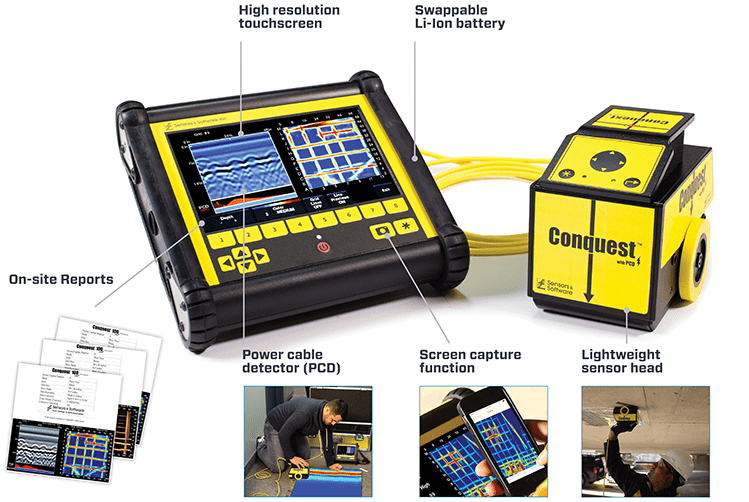Discover Hidden Obstacles with RainierGPR Concrete Scanning Technology
The Importance of Specific Concrete Scanning in Finding Underground Hazards
The ability to precisely identify and map these below ground dangers is not merely a matter of convenience but a vital aspect of ensuring the security of both construction workers and the integrity of the project itself. By releasing sophisticated scanning technologies and approaches, specialists can uncover concealed risks, prevent costly problems, and inevitably lead the means for smoother and safer building and construction undertakings.
Advanced Scanning Technologies for Detection
Innovative radar systems are transforming the area of underground discovery by providing unequaled precision and effectiveness. These advanced scanning innovations use ground-penetrating radar (GPR) to produce in-depth photos of subsurface structures, using insights right into what lies underneath the surface area with exceptional quality. By sending out high-frequency pulses into the ground and determining the representations, radar systems can identify variations in material make-up and spot underground risks such as cables, spaces, and pipelines.
One of the crucial advantages of these sophisticated radar systems is their non-invasive nature, enabling thorough examinations without triggering damage to the existing frameworks. This not only makes sure the safety of the surrounding atmosphere however additionally minimizes the need for costly fixings or disturbances to recurring building tasks. Furthermore, the real-time data supplied by these scanning modern technologies allows fast decision-making and improves general job performance.
Significance of Subsurface Mapping

Accurate subsurface mapping helps in stopping expensive damages to existing below ground infrastructure, reducing the threat of crashes, and maintaining job timelines. It allows project managers to make informed decisions relating to site planning, equipment implementation, and source appropriation. Furthermore, subsurface mapping permits far better sychronisation amongst various groups dealing with a project and helps in adhering to governing needs related to underground energy discovery.
Mitigating Threats in Construction Jobs
Efficient risk reduction techniques are important for guaranteeing the success and safety and security of building tasks. One essential facet of mitigating threats in construction projects is extensive planning and evaluation at the initial phases.
In addition, developing clear communication networks amongst all task stakeholders and making certain stringent adherence to safety and security protocols are crucial parts of threat mitigation. By proactively carrying out robust danger mitigation techniques, construction jobs can lessen delays, expense overruns, and safety occurrences, find more eventually leading to successful project outcomes.

Avoiding Expensive Problems and Delays
To minimize economic losses and job obstacles, effective strategies should be implemented to protect against expensive problems and delays in building and construction jobs. Recognizing these blockages early on helps in intending the job layout extra efficiently and avoiding possible problems throughout excavation.
Furthermore, spending in training programs for building and construction employees on the significance of concrete scanning and risk-free excavation methods can considerably reduce the danger of crashes and delays. reference Clear communication channels between project supervisors, engineers, and on-site workers are likewise necessary to make certain that everyone knows the potential risks and follows the needed procedures to avoid expensive damages. By prioritizing aggressive steps like concrete scanning and advertising a society of safety and awareness, building and construction tasks can reduce the economic effect of unexpected underground obstructions and stay clear of pricey delays.
Ensuring Safety And Security of On-Site Worker
By prioritizing aggressive steps such as extensive training programs and clear communication channels, building projects can make sure the security of on-site employees in the middle of the possible threats discovered via concrete scanning. Correct training gears up workers with the knowledge and abilities required to browse construction sites safely, especially when risks are determined via scanning procedures. Training must cover risk recognition, emergency situation treatments, and the proper utilization of individual safety devices to reduce risks effectively.
Furthermore, establishing clear interaction networks is critical for distributing details about identified hazards quickly. This guarantees that all on-site personnel know prospective dangers and can take necessary safety measures to avoid crashes. Regular safety and security rundowns, tool kit talks, and constant updates pertaining to scanning results assistance maintain everyone educated and positive in keeping a safe working setting.
Additionally, implementing stringent adherence to security procedures and laws, carrying out routine security audits, and cultivating a society of safety and security pop over to these guys awareness amongst workers are important parts in guaranteeing the well-being of on-site workers throughout building and construction projects - RainierGPR Concrete Scanning. Positive safety and security procedures not only safeguard workers from harm yet additionally add to the total success and efficiency of the project
Verdict
Finally, specific concrete scanning plays a critical function in identifying below ground threats. Utilizing advanced scanning technologies and subsurface mapping helps minimize risks in building and construction jobs, stopping expensive damages and delays. By making certain the security of on-site workers, exact scanning can significantly enhance the effectiveness and success of construction procedures. It is critical for building firms to focus on making use of specific scanning approaches to decrease possible hazards and make sure a smooth building and construction procedure.
By proactively carrying out robust risk reduction approaches, building and construction tasks can minimize delays, price overruns, and security incidents, inevitably leading to effective project results. - RainierGPR Concrete Scanning
To reduce financial losses and task setbacks, reliable techniques must be implemented to protect against expensive damages and hold-ups in construction tasks. By focusing on proactive actions like concrete scanning and promoting a culture of safety and security and awareness, building jobs can lessen the economic impact of unforeseen below ground obstructions and stay clear of costly hold-ups.
By prioritizing proactive procedures such as thorough training programs and clear communication channels, building and construction tasks can make certain the safety of on-site employees amidst the potential dangers detected via concrete scanning. Making use of innovative scanning innovations and subsurface mapping aids alleviate risks in building projects, avoiding expensive problems and delays.